| Report Type | Full |
| Peak(s) |
Crestone Needle - 14,196 feet |
| Date Posted | 06/07/2008 |
| Modified | 06/08/2008 |
| Date Climbed | 06/01/2008 |
| Author | firsttracks |
| Ellingwood Arete |
|---|
|
In 2001, I climbed Crestone Needle for the first time. My climbing buddy Chuck Booten and I ran into a pair of climbers who were tackling the Ellingwood Arete, a beautiful line running 2000' vertical and framing the right side of the mountain. We climbed the standard route, and then bagged Humboldt, and then still beat them back to the car. They said it was a brutally long day, and much harder than they thought. Those of you that know me know that a statement like that is usually all it takes to get my competitive juices flowing. Fast forward almost seven years, and we were finally making the drive. I arrived at the 2WD parking at 2pm on Saturday, and waited for Chuck to arrive. An hour later, Chuck finally showed up. Turns out, he spent the night before (his 30th birthday) out partying, so he was still in recovery mode. We began our gear sort before piling into my trusty 1997 Isuzu Rodeo for the approach up to South Colony Lakes. That's when I realized a critical mistake: I somehow forgot my backpack, along with my sleeping bag, crampons, hat, and gloves (packed inside)! That's my biggest bone-head move ever. Luckily, Chuck keeps a gear store in his trunk. He pulled out an extra pack, a spare set of crampons, and a blanket. We finally were ready. Our final gear list: Climbing Gear 60m 8mm rope Set of hexes Set of nuts Tri-cams: 2 x 0.125 (silver), 2 x 0.250 (black), 2 x 0.50 (pink) #0.75 Camalot #2 Link Cam (range of 0.75 - 2) 6 x single length, 3 x double length, 1 x quad length slings Rock Shoes / Harness Ice Axe / Ice Tool Winter Boots Crampons Snowshoes Trekking Poles Camping Gear Stephenson Tent (< 3 lb) Sleeping Bag (Chuck) / Blanket (Ryan) Pocket Rocket Stove Pot South Colony Lakes Road -- The Drive As we got ready to start the drive, a van showed up. Three climbers (James, Jamie, and Chelsea) were also planning on climbing the Ellingwood Arete! We waited for them to sort gear, and then all five of us piled in. We hit the road at 4pm. The road was actually in good shape. Fully loaded, we still made it up past the river crossing and past the Rainbow Trail. Eventually snow stopped further progress. The Hike to Camp We generally stayed to climber's right on the road, and we avoided snow. We made it to the trailhead and crossed the log bridges. At that point, we had to put on snowshoes for the hike on soft snow to the lake. We made good time. We were at Lower South Colony Lake around 6pm. We had a great view of the climb ahead: 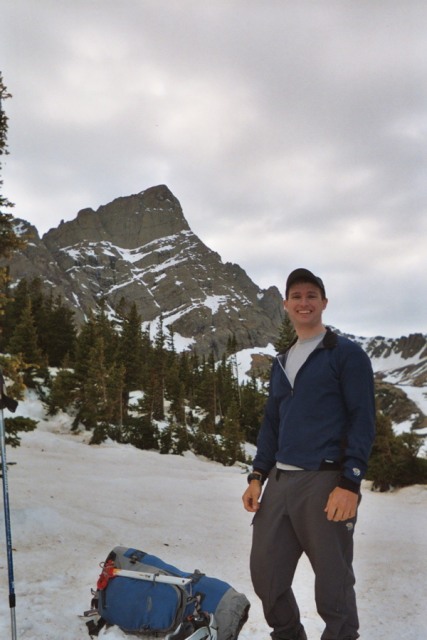 We set up camp, cooked dinner, melted water, and were in bed by around 9:00. We talked about our wake-up time, and settled on 4:30. We wanted to be at the base of the climb around 6am. The Approach There wasn't a hard freeze that night, but the snow was still firm as we made our way towards the base of the climb. We decided to opt for the direct start, which adds 1-2 pitches of 5.3 - 5.4 climbing. Mostly, this was because the standard shortcut up the grass was still covered in snow. But, we were happy to tackle the entire arete. We still had to climb a pitch of snow to get to the base of the climb. The snow was firm and delightful! I swung my ice tool happily into the neve, and kicked steps in my boots. We didn't bother with crampons. We arrived at the base of the climb just ahead of the other climbing party. We were thankful -- we didn't want to get stuck behind a threesome. The Climb The first pitch looked fun: 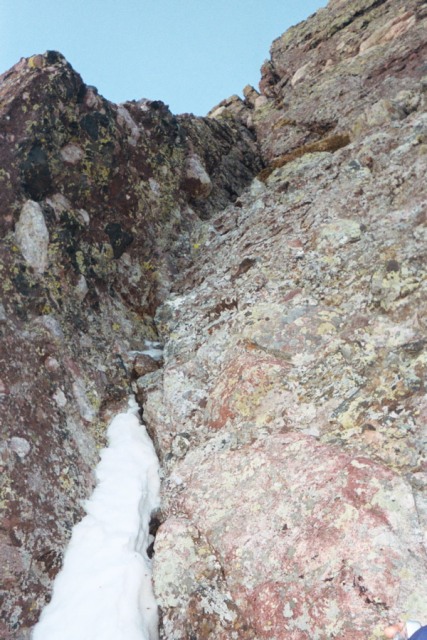 We quickly put on our harnesses and grabbed the rack. Chuck took the lead and was on the rock at 6am sharp. Our general plan was to simul-climb the route until the head wall crack at the top. After about only a pitch of climbing, though, Chuck yelled down at me that he set an anchor. The route took a sharp right up around a wall, and he decided to belay me up to that point to eliminate ridiculous rope drag. The sun started to warm us up. Here's Chuck at the first anchor:  The climbing ahead looked easy, and we prepared to start a long simul-climb (until the gear ran out): 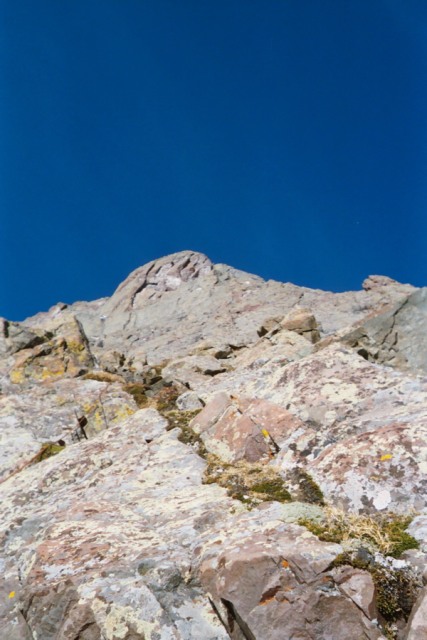 Unfortunately, just after I started climbing this pitch, I broke a ledge loose, and I took about 100 lb of rock fall right on my left knee. It started swelling up, so I knew I'd better keep moving to keep it under control. Although the route is mostly solid, some ledges can break away. Also, watch for loose rocks on the ledges themselves. Chuck continues climbing above me on the Arete:  The climbing here was mostly easy, but it definitely made you think. It wasn't quite as flat as the pictures make it out to be. We made good progress until about half way up. Then, we ran into a wall. Chuck had climbed up the left side (around 5.7), but the rope got stuck towards the middle of the overhung wall (around 5.10ish). I struggled to get slack to free the rope. Communication was difficult: we elected to go full-length instead of half-length on the rope anticipating run-outs. It took me probably 40 minutes to free the rope above me so that I could climb up the left side (using flakes). I believe this spot is at the very top of this picture to the right of the bulge: 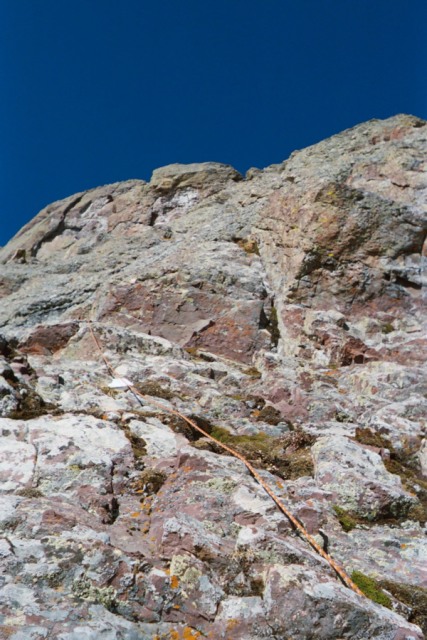 Above this spot, things got easy again. The upper ridge was a bunch of fun. The exposure increased with the angle, and the route started to show itself better:  Here's a view looking at the saddle of Humboldt and the Upper Lake: 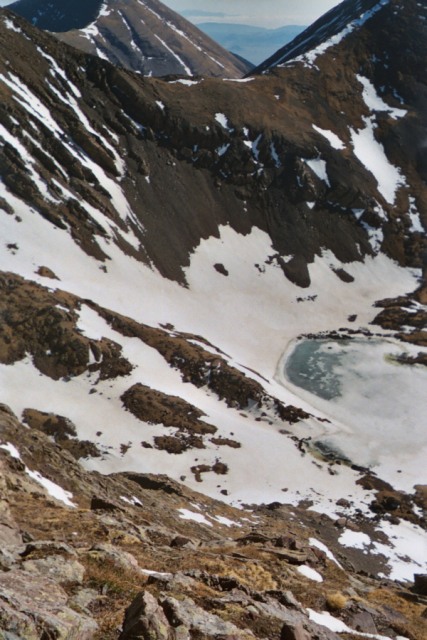 Here's a shot of the corner that Chuck is just about to reach in the picture (2 pictures) above: 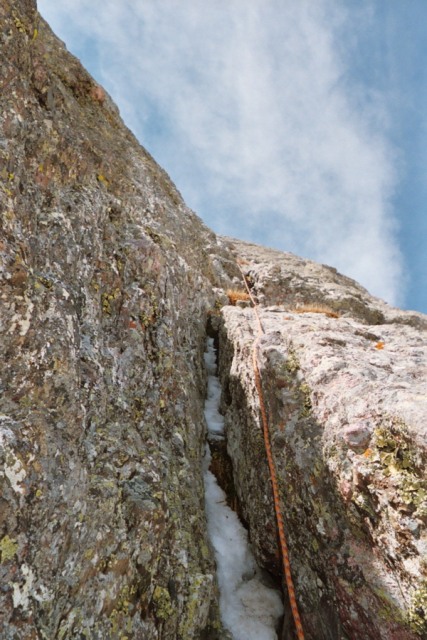 Here, we found a couple old pitons. I always like finding old climbing gear because it gives a sense of history. It's amazing to me that Albert Ellingwood climbed this route in the 1920's, well before pitons were around these parts! At the top of the gully, Chuck set an anchor that would give us a view of the crux pitch to come. Here's Chuck at the top of the gully:  Although you see snow in the picture, the route was really mostly dry. The snow was all avoidable, and we only had to chip out snow/ice for a couple gear placements. Finally, the time had come. We were at the base of the crux pitch. I believe this is the place where you have three options: go left (like we did), or take the middle or right cracks for easier climbing. Although I recommended that we go right, Chuck thought the climbing looked easier to the left. Here's Chuck just before the crux move:  Immediately above Chuck, the chimney gets awkward. Chuck stemmed out onto the left arete (hard to see in the pic above), where he found another piton. He clipped it, climbed on the arete for another move, and then made it back into the chimney. This climbing was awkward. We both thought it was around 5.8-5.9. I believe staying on the left arete would give easier climbing (there was a second piton above, along with easy climbing), but I had to re-enter the chimney / crack to pull gear. Thanks, Chuck. I joined Chuck at the anchor above the crux pitch, and we enjoyed some good views of Humboldt. We knew we were close to the summit:  Here's a self-photo at the last anchor: 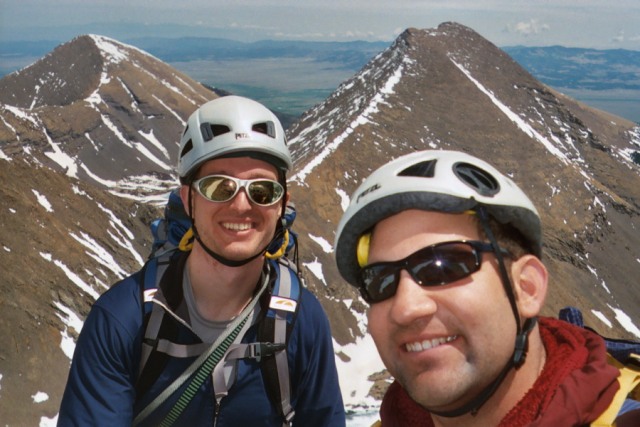 We could see a cornice above, so we figured we were down to the last few moves:  Chuck got busy, and made quick work of the last pitch. 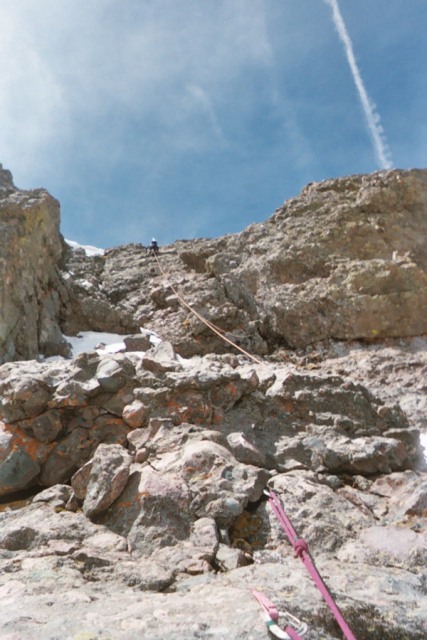 I quickly followed, camera in hand to show the last few feet of the climb:  Finally, the summit appears:  I arrived at the summit at 12:30 sharp (for a route time of 6 hours, 30 minutes), and took the obligatory summit (victory) shot: 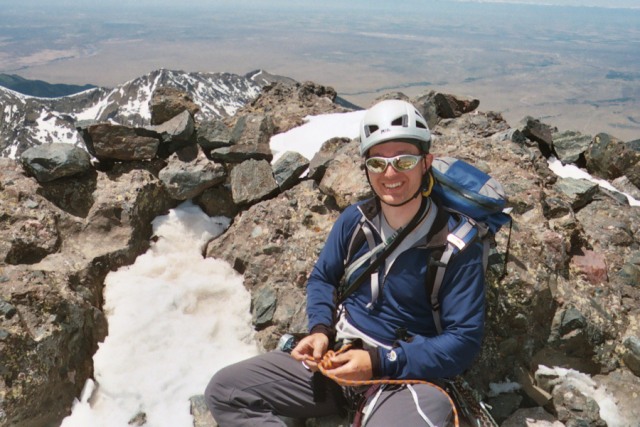 We changed out of our climbing shoes and put on the boots that had been in our packs all day. Before starting down, I had Chuck take a summit shot of me, looking towards Crestone Peak: 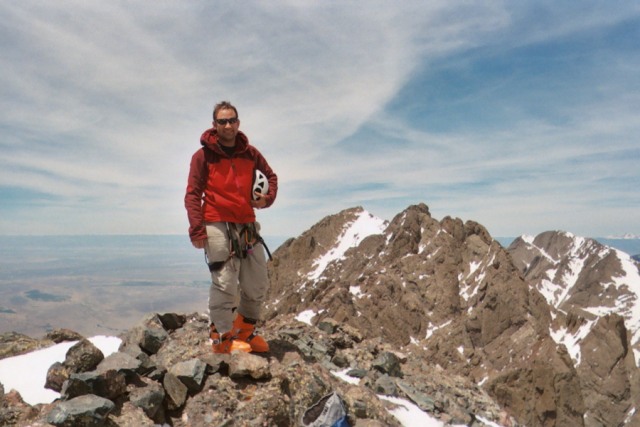 The Descent The descent was actually the crux (in my view). There was still snow in the gullies, and it was a mix of slush/ice/soft snow. We tried to stay on the rock outcrops to avoid the snow: 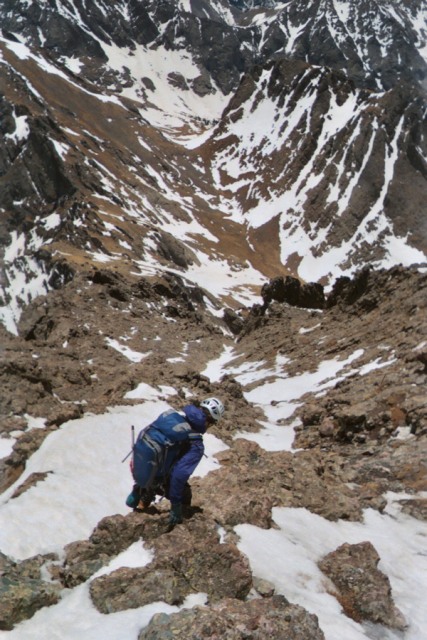 After being tied to a rope all morning, I definitely felt uncomfortable facing the down climb in my awkward AT boots. Although I had wanted my AT boots for kicking steps and cramponing on the descent, I was kicking myself for not bringing leather boots considering our rocky descent path. Broken Hand Pass finally arrived. We were back at camp after a descent time of 3 hours, 30 minutes. We melted more water for the hike out, packed up our stuff, and headed back to the car. It was a really long day. We didn't make it back to the car until about 6pm. The Drive Out To further complicate things, the river crossing on the road was raging -- much more water flow than when we crossed the day before. We took our chances, and made it through the water. Shortly afterwards, we encountered a tree that fell across the road. I didn't have a saw, so we had to Leatherman it. It took a while! We were finally done with the trip. Final Impressions The Ellingwood Arete is a great climb! It is more strenuous than you might think, and we both agreed that there were some 5.8 - 5.9 moves on the climb. Additionally, the climb is fairly run-out on the Crestone Conglomerate. It is fun to pull on the knobs all day long, but you won't find that many great placements. Be careful! We were planning on finishing the route in about 3 hours. We were more than double that time. Don't underestimate this one -- it's harder / longer than you might think. I really enjoyed my day out there, and it was really satisfying to complete a goal that we've both had for seven years. And, we believe we were the first ascent of the year (no signs of any previous party in the snow that remained on the route). That was an extra bonus. Summer climbing season has arrived. |
| Comments or Questions | |||||||||||||||
|---|---|---|---|---|---|---|---|---|---|---|---|---|---|---|---|
|
Caution: The information contained in this report may not be accurate and should not be the only resource used in preparation for your climb. Failure to have the necessary experience, physical conditioning, supplies or equipment can result in injury or death. 14ers.com and the author(s) of this report provide no warranties, either express or implied, that the information provided is accurate or reliable. By using the information provided, you agree to indemnify and hold harmless 14ers.com and the report author(s) with respect to any claims and demands against them, including any attorney fees and expenses. Please read the 14ers.com Safety and Disclaimer pages for more information.
Please respect private property: 14ers.com supports the rights of private landowners to determine how and by whom their land will be used. In Colorado, it is your responsibility to determine if land is private and to obtain the appropriate permission before entering the property.
